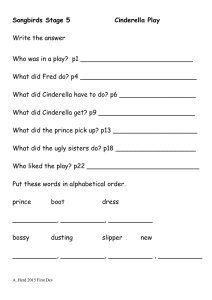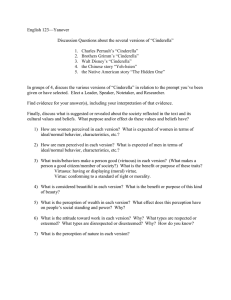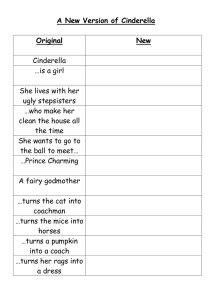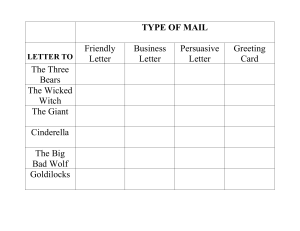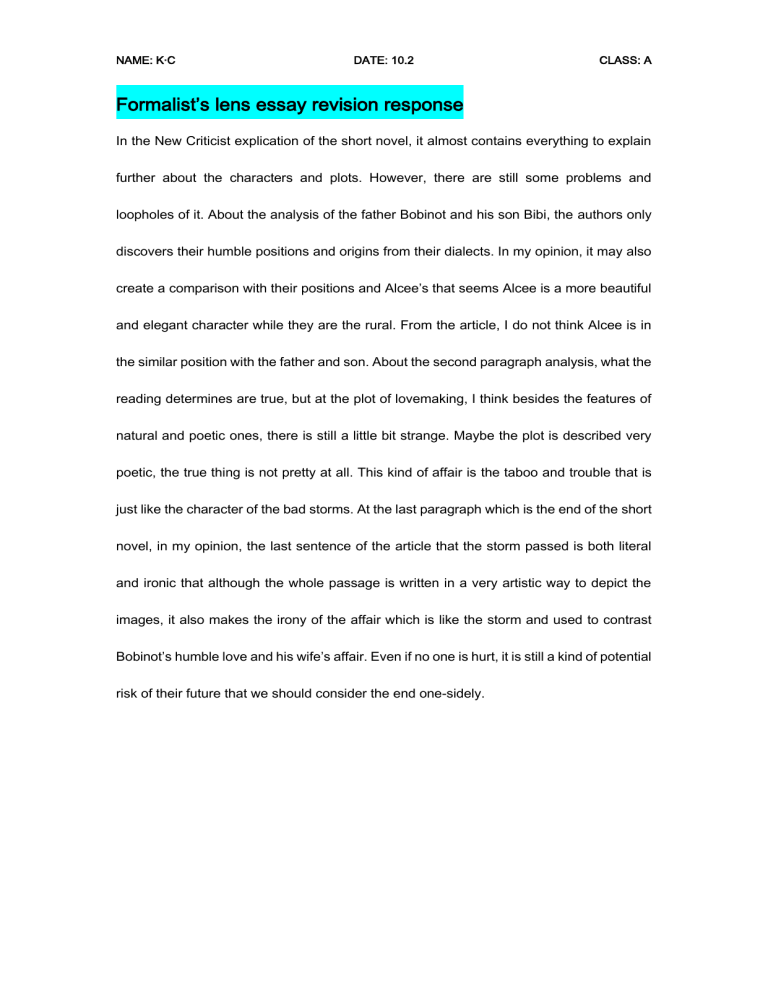
NAME: K·C DATE: 10.2 CLASS: A Formalist’s lens essay revision response In the New Criticist explication of the short novel, it almost contains everything to explain further about the characters and plots. However, there are still some problems and loopholes of it. About the analysis of the father Bobinot and his son Bibi, the authors only discovers their humble positions and origins from their dialects. In my opinion, it may also create a comparison with their positions and Alcee’s that seems Alcee is a more beautiful and elegant character while they are the rural. From the article, I do not think Alcee is in the similar position with the father and son. About the second paragraph analysis, what the reading determines are true, but at the plot of lovemaking, I think besides the features of natural and poetic ones, there is still a little bit strange. Maybe the plot is described very poetic, the true thing is not pretty at all. This kind of affair is the taboo and trouble that is just like the character of the bad storms. At the last paragraph which is the end of the short novel, in my opinion, the last sentence of the article that the storm passed is both literal and ironic that although the whole passage is written in a very artistic way to depict the images, it also makes the irony of the affair which is like the storm and used to contrast Bobinot’s humble love and his wife’s affair. Even if no one is hurt, it is still a kind of potential risk of their future that we should consider the end one-sidely. NAME: K·C DATE: 10.2 CLASS: A NAME: K·C DATE: 10.2 CLASS: A Yellow Wallpaper New Historicist Intersectional profile questions Personal profile Age: 16 Class: proletariat Race: Chinese Gender: male Occupation: student Live in Suzhou; study at Suzhou High School; 4 members in my family including myself; love sports, such as basketball, tennis, formula1 (just watch the races), surfing; love most of the music styles except the classical ones; ability of playing different kinds of drums; do not like playing electronic games; stay in many clubs like bands; want to learn engineering in the university in the future; like to travel that want to study in western coast of America; no conspicuous imbalance in every disciplines; have a good social ability; like to playing some toys; lack of patience; flaw on time management Analysis of the article At that time, there are many sources of pressure from different kinds of things. And there are many inequalities between different kinds of groups of people, such as racism and sexism. In the time period of authors which is very similar of that in the story, women were suffering from the sexism and some inequalities, just like what pointed out in the storyhouse arrest. Besides the inequalities, women also face many other worries from both NAME: K·C DATE: 10.2 CLASS: A physical and mental. About the depression, this comes from both people’s internal and external influence. In the actual life of authors, which is similar with what depicts in the story, she suffered from the environment and her own illness. She and the character she created faced the sexism that women should not be liberated, but restrict under their husbands’ control. Because of these too much pressure and limitations, it is reasonable for them to fall into depression. And the relations between female and male, in my opinion, the marriage is also a kind of this. In the story, we can see a silly woman who likes to fancy and is willing to follow her husband, while his husband misjudges something and restrict her. Perhaps in the story, the relationships between this couple is true love, but they are both deeply influenced by the inequality, or stereotype of that women should always listen to their husbands. There is not a balance, or equality of them. The man just does the wrong judgement and his wife just follow him, though it is harmful for herself. She is not able to do the right decision. They are all the victims of this negative phenomenon, but they are unconscious about it and are still ruled by it. PTSD in the story is the reaction of the character fancying there is women creeping behind the wall-paper and she eventually does the same thing. This problem is caused by the environment that her husband exerts on her, which is queer. PTSD becomes worse when her imagination becomes out of control and she is at the position of confusion. She is unable to correctly judge the reality and the fancy. There are several conflicts in the story. The conflicts between the character and his husband on the problem of whether she is ill, the conflicts of imagination and reality. These conflicts are all generated form the inequalities of male and female. They cannot reach an agreement of the truth, although they are in the same direction, they are in the wrong way NAME: K·C DATE: 10.2 CLASS: A to solve problems. I prefer to stand for the wife in the story but not one hundred percent. She is a typical victim of female that suffer from the inequality of sex. She is very poor that she does not have her own judgement of life except fancy. She is locked in the cage, and this pressure eventually makes her crazy and insane. NAME: K·C DATE: 10.2 CLASS: A Cask of Amontillado psychological profile and questions for Montressor Montresor’s motivation to kill Fortunato is that Fortunato always injuries him with insult and he cannot tolerate due to Montresors’ motto and his esteem. In my opinion, Montresor does preserve his ego through the killing. The satisfaction of him is to kill Fortunato to achieve the revenge, which is he really hope to do. Although, as we all known, whenever you kill the man, this is a destruction and disregard of Superego that ignore the rules of society, he still does that. However, in this process, there is fluctuation in his mind too. He still preserves the quality of a human because at the middle of the road, he does not determine and hesitates whether to do this crime that demonstrates he has the quality of humans. But the result is bad since he succumbs to his desire, ID. Montresor’s ID is to kill Fortunato, which is opposite to Superego that killing is forbidden in the society. In the article, from the beginning to some details like his family’s motto, they all reflects his ID. Nevertheless, there is also some points that Superego restricts him. He used to hesitate and be afraid of what he has done. NAME: K·C DATE: 10.2 CLASS: A Cinderella double notation and response questions CINDERELLA THEME OF WOMEN AND FEMININITY The narrator of "Cinderella" has a pretty dim view of certain tendencies that women have (according to said narrator). Between the nursemaid who uses her looks to get ahead, Cinderella's use of the white dove only to marry the prince, and the stepsisters' gruesome acts of self-mutilation—all done to get a husband—the narrator paints a super-cynical view of femininity and womanhood. Stands to reason, really. Anne Sexton, like Sylvia Plath, had tortured relationships with gender, gender roles, and the place of women in society, so this theme crops up not only in "Cinderella," but in a ton of Sexton's work. Women are foolish, superficial, and single-minded in this poem. Yikes. But the way in which the narrator snidely caricatures the women in "Cinderella" shows us that she doesn't think women should be like this. Questions About Women and Femininity 1. Does Cinderella seem like a "strong" or "weak" woman in this poem? Why? Weak. Because in the story, there are a lot of help to Cinderella from the pigeons and her mother’s soul which is not earnt by herself. She just has the willingness to go to the marriage market, but she does not have the ability to counteract the life. 2. How does the poem portray marriage? The marriage of the prince and Cinderella is very happy, fortunate, and romantic. Also, the bad ones deserve the punishment. The marriage is the happy ending. 3. How would you characterize the relationships between men and women in this poem? NAME: K·C DATE: 10.2 CLASS: A The relationship between men and women is pretty dramatic. Since in the whole poem, there is only one relationship depicted in details that is between the prince and Cinderella, the relationship is described positively. The prince never gives up to chase for his true love, and in the end, they live in a romantic and sweet life that creates a positive and dream picture of relationship between men and women. 4. Do you think that superficiality (shallowness) is tied to gender in this poem? Why or why not? Yes. The poem about Cinderella just repeats the fairy tales wholly without any expressions and discussion about the opinion of author. The poem seems very shallow, but I think the author simply expresses her feelings through the form of the poem. She wants to use this shallow form to criticize the fairy tales that shapes the negative characters about women. She disagrees with the descriptions in the fairy tales by using the shallow form to criticize the shallow description in satire. Start a debate or play the devil’s advocate with the following points. Write some short responses in the blank space to give you talking points: In "Cinderella," one of the ways the narrator's cynicism comes through is through her portrayal of women as passive and submissive. Talk about bitter! In the fairy tale and the narration in the poem, although the author does express her cynicism about the description of woman, the characterization of them is not fully passive and submissive. For example, the character about Cinderella is both sides that we cannot judge her only in one side. Perhaps in the story, she behaves very cowardly that she submits to her sisters and stepmother to be a maid. This can seem to be a phenomenon of weakness. But if we stand in another side, can everybody tolerate this kind of torment without any complaint. I think this kind of tolerance is a valuable quality for people to develop to be such a tough person whenever facing trouble. Cinderella, as the main character of the narrative, is a surprisingly weak protagonist and disappoints as a female role model. In other words, she gets an "F," and it's not for feminist. Just as what I mentioned above, maybe there are some weaknesses of Cinderella that she submits to her bad sisters and stepmother to be a maid without any resistance, and she is very afraid and weak when facing the prince that these characterizations is very different from what feminist advocates. However, in some sides, she acts pretty properly as a female role model. From her, there is the quality of tolerance that help people learn how to become tough and face the trouble calmly that is an important value for women, or for everybody. NAME: K·C DATE: 10.2 CLASS: A CINDERELLA THEME OF WEALTH The entire poem of "Cinderella" hinges on wealth, really. It, and women's pursuit of it, are the major thematic elements of the piece. The example "Cinderella stories" (sarcastically called "that story" over and over again) all involve cold, hard, skrilla, and Cinderella gets to the ball by way of having beautiful, presumably pricey clothing (even though, of course, she gets it magically and for free). When the stepsisters get riches and jewels, Cinderella gets a twig (gee, thanks)—which signifies that her life is awful. Marrying the prince is of utmost importance for everyone, and not, according to the poem, because the prince is handsome. Being married to a prince is almost always associated with having all kinds of dollar—not necessarily being married to someone you actually love. So throughout "Cinderella," the theme of wealth is used to illustrate how incredibly superficial people can be and the crazy things that money propels some people to do. Questions About Wealth 1. How is wealth measured in this poem? In the poem, the wealth is measured by the objects, such as beautiful clothes, pretty shoes, and jewels that make women look more charming. The wealth is only measured by the materials, the surface. 2. How do you think the poem elaborates on the old adage "money doesn't buy you happiness"? In my opinion, there are two explanations for this old adage. For the first reason, it reflects from Cinderella that though Cinderella goes to the party with very fancy clothes, she loses her shoes that makes her feel worried and unhappy because she does not want the prince realize the truth. The wealth makes her meet the prince, but also makes her fall in love with him and miss him which makes her paradoxical. In another point, about her sisters, it is obvious that her sisters are both very desired to be the wife of the prince. Nevertheless, they meet Cinderella which dresses more beautiful than them and seems wealthier. So, in this example, maybe wealth can make you happy, but at the same time, it makes you unhappy since they must be someone wealthier, or greater than you that the envy makes people unhappy. 3. What might you say about the narrator's view of money based on the poem? In the poem, the narrator considers the money is one of the origins of the discrimination because there are many differences between person and person is caused by difference of wealth, such as the difference positions of Cinderella and her sisters. 4. How are money and marriage tied together in this poem? NAME: K·C DATE: 10.2 CLASS: A The money is considered as the requirement and the connection for the marriage of people in the same level. Start a debate or play the devil’s advocate with the following points. Write some short responses in the blank space to give you talking points: What's love got to do with it? The pointed phrase "marriage market" (42) sheds light on the poem's view of marriage as an economic arrangement. I do not think this idea would make sense since the wording is ironic to express the author’s feelings. Maybe in some time periods like nowadays, people pay more attention to the money as a factor to the marriage, but there are still some exceptions. Just like what shown in the poem, if the marriage is really as an economic arrangement, why does the prince marry Cinderella eventually though he knows the truth that Cinderella does not have any money at all. In author’s opinion, it is reasonable for him to choose other wealthy ladies. This instance reflects that there is still true love. "Wealthy" in "Cinderella" might be seen as a synonym for "soulless." Standing on the point of Cinderella’s sisters, “wealthy” can be a synonym for “soulless” since they desire for the life of wealth regardless any means to get that, which are crazy and soulless behaviors. Nonetheless, standing on the point of the prince, although he is the prince that he must have amount of wealth, and there are many other wealthy and pretty ladies in the party, he falls in love with Cinderella. He does not lose his mind with wealth. Instead, he neglects the importance of money but to follow his heart to marry a poor girl. “Cinderella” by Anne Sexton NAME: K·C DATE: 10.2 You always read about it: the plumber with the twelve children who wins the Irish Sweepstakes. From toilets to riches. That story. Or the nursemaid, some luscious sweet from Denmark who captures the oldest son's heart. from diapers to Dior. That story. Or a milkman who serves the wealthy, eggs, cream, butter, yogurt, milk, the white truck like an ambulance who goes into real estate and makes a pile. From homogenized to martinis at lunch. Or the charwoman who is on the bus when it cracks up and collects enough from the insurance. From mops to Bonwit Teller. That story. Once the wife of a rich man was on her deathbed and she said to her daughter Cinderella: Be devout. Be good. Then I will smile down from heaven in the seam of a cloud. The man took another wife who had two daughters, pretty enough but with hearts like blackjacks. Cinderella was their maid. She slept on the sooty hearth each night and walked around looking like Al Jolson. Her father brought presents home from town, jewels and gowns for the other women but the twig of a tree for Cinderella. She planted that twig on her mother's grave and it grew to a tree where a white dove sat. Whenever she wished for anything the dove would dropp it like an egg upon the ground. The bird is important, my dears, so heed him. CLASS: A NAME: K·C DATE: 10.2 Next came the ball, as you all know. It was a marriage market. The prince was looking for a wife. All but Cinderella were preparing and gussying up for the event. Cinderella begged to go too. Her stepmother threw a dish of lentils into the cinders and said: Pick them up in an hour and you shall go. The white dove brought all his friends; all the warm wings of the fatherland came, and picked up the lentils in a jiffy. No, Cinderella, said the stepmother, you have no clothes and cannot dance. That's the way with stepmothers. Cinderella went to the tree at the grave and cried forth like a gospel singer: Mama! Mama! My turtledove, send me to the prince's ball! The bird dropped down a golden dress and delicate little slippers. Rather a large package for a simple bird. So she went. Which is no surprise. Her stepmother and sisters didn't recognize her without her cinder face and the prince took her hand on the spot and danced with no other the whole day. As nightfall came she thought she'd better get home. The prince walked her home and she disappeared into the pigeon house and although the prince took an axe and broke it open she was gone. Back to her cinders. These events repeated themselves for three days. However on the third day the prince covered the palace steps with cobbler's wax and Cinderella's gold shoe stuck upon it. Now he would find whom the shoe fit and find his strange dancing girl for keeps. He went to their house and the two sisters were delighted because they had lovely feet. The eldest went into a room to try the slipper on CLASS: A NAME: K·C DATE: 10.2 but her big toe got in the way so she simply sliced it off and put on the slipper. The prince rode away with her until the white dove told him to look at the blood pouring forth. That is the way with amputations. They just don't heal up like a wish. The other sister cut off her heel but the blood told as blood will. The prince was getting tired. He began to feel like a shoe salesman. But he gave it one last try. This time Cinderella fit into the shoe like a love letter into its envelope. At the wedding ceremony the two sisters came to curry favor and the white dove pecked their eyes out. Two hollow spots were left like soup spoons. Cinderella and the prince lived, they say, happily ever after, like two dolls in a museum case never bothered by diapers or dust, never arguing over the timing of an egg, never telling the same story twice, never getting a middle-aged spread, their darling smiles pasted on for eternity. Regular Bobbsey Twins. That story. CLASS: A
